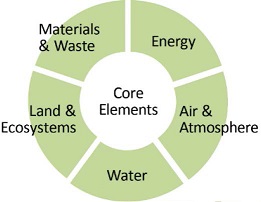Superfund Green Remediation
Featured News
-
Perspectives on the Implementation of Greener Cleanups shared in recent EPA webinar.
In the Superfund program, green remediation is the practice of considering all environmental effects of remedy implementation and incorporating options to minimize the environmental footprints of cleanup actions.
On this page:
- Making each Superfund cleanup "greener"
- Evaluating greener cleanup activities throughout the CERCLA process
- Optional use of an industry standard
- Best management practices (BMPs)
- Footprint analysis for environmental cleanups
Making Each Superfund Cleanup "Greener"
Green remediation strategies can help minimize the environmental footprint of cleaning up Superfund sites and ensure protective remedies within the Superfund statutory and regulatory framework, as established by the Comprehensive Environmental Response, Compensation, and Liability Act (CERCLA) and the National Oil and Hazardous Substances Pollution Contingency Plan.
Green remediation strategies aim to reduce total energy use and increase the percentage of energy from renewable resources; reduce air pollutants and greenhouse gas emissions; reduce water use and preserve water quality; conserve material resources and reduce waste; and protect land and ecosystem services.  Opportunities to decrease the footprint and maximize the environmental outcome of a cleanup exist throughout the life of a project, from site investigations through development of cleanup alternatives and remedy design, construction, operation and monitoring.
Opportunities to decrease the footprint and maximize the environmental outcome of a cleanup exist throughout the life of a project, from site investigations through development of cleanup alternatives and remedy design, construction, operation and monitoring.
EPA's Principles for Greener Cleanups provide the foundation for institutionalizing green remediation best practices (BMPs) across the Superfund program.
Integration of the Principles within Superfund program operations is facilitated by EPA’s transition to the Superfund Remedial Acquisition Framework. The framework provides work scopes that include green remediation reviews to be performed under the Agency’s suite of national Superfund service contracts.
Evaluating Greener Cleanup Activities throughout the CERCLA Process
In August 2016, EPA issued a guidance memorandum recommending approaches for regional Superfund programs to consider when evaluating greener cleanup activities through the CERCLA process. The guidance also encourages regions to consider conducting an environmental footprint analysis to help identify best practices that may help minimize the footprint on a site-specific basis. Relevant parts of the CERCLA process include site characterization; remedial investigation and feasibility study or engineering evaluation/cost analysis; development of decision documents; and enforcement mechanisms.
- Consideration of Greener Cleanup Activities in the Superfund Cleanup Process (PDF)(14 pp, 2.6 MB, About PDF)
Optional Use of an Industry Standard
Superfund stakeholders partnered with others in the site cleanup community to develop a voluntary, consensus-based standard for greener cleanups. ASTM International issued the resulting Standard Guide for Greener Cleanups in November 2013. In a subsequent memorandum, EPA recognized the standard as a tool that, when implemented appropriately, can reduce the environmental footprint of cleanup activities while still meeting site-specific regulatory requirements and objectives. Stakeholders and partners further collaborated in revising the standard, as issued in 2016.
- Standard Guide for Greener Cleanups EXIT (E2893-13) and subsequent Memorandum (PDF) EXIT(3 pp, 626 K)
Best Management Practices (BMPs)
EPA's series of BMP fact sheets describe practices for frequently used remedies, various field stages and other aspects posing significant opportunities to reduce the environmental footprint of cleanups. Topics of the 13 fact sheets developed to date include soil vapor extraction, groundwater pump and treat technologies, landfill cover systems, site investigation, and renewable energy applications. Each fact sheet address all five core elements of a greener cleanup.
Footprint Analysis for Environmental Cleanups
EPA developed a methodology to analyze and quantify the environmental footprint of activities often involved in contaminated site cleanup. The methodology uses 21 specific metrics and a seven-step process to quantify the footprint. Information gained by applying the methodology to a specific site can be used to identify BMPs addressing footprint contributions of particular concern.
- Methodology for Understanding and Reducing a Project’s Environmental Footprint (PDF)(135 pp, 2.1 MB)
If you have questions about green remediation strategies at Superfund sites, please contact an EPA regional or national program representative.
- Superfund Green Remediation Coordinators: For regional and site-specific information, contact a coordinator in the corresponding EPA region.
For other information, contact Carlos Pachon (pachon.carlos@epa.gov) in EPA’s Office of Superfund Remediation and Technology Innovation.
